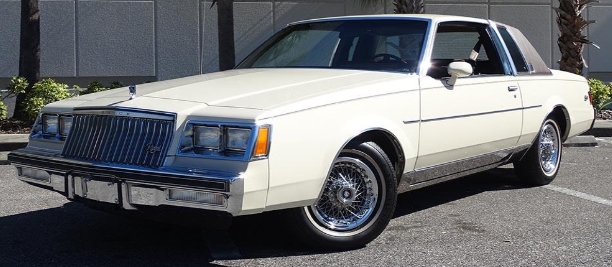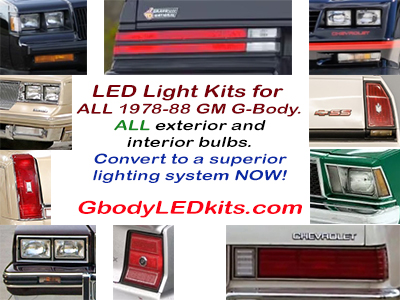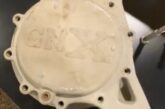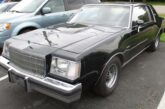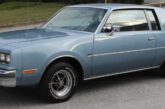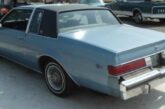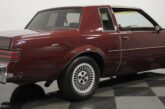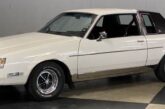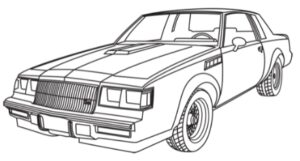1983 Buick Regal Coupe, 1983 Buick Regal Sedan, 1983 Buick Regal Estate Wagon, 1983 Buick Regal Limited, 1983 Buick Regal T-Type
In the automotive landscape of 1983, the American personal luxury coupe still held significant sway. It was a time of transition, as the horsepower-strangling “Malaise Era” was reluctantly giving way to a new age of electronic fuel injection and turbocharging. At the forefront of this shift was General Motors, and one of its most versatile nameplates was the Buick Regal. Built on the robust, rear-wheel-drive G-body platform, the 1983 Regal wasn’t just a single car; it was a broad family of vehicles designed to appeal to vastly different buyers. From the plush comfort of the Limited to the surprising performance of the T-Type, the Regal lineup offered a model for nearly every taste and need. To understand the 1983 Buick, one must look at each member of this distinguished family.
The Common Ground: The G-Body Foundation
Before dissecting the differences, it’s essential to understand what all 1983 Regals shared. Every variant was based on the GM G-body chassis, a traditional body-on-frame design known for its smooth ride and durability. The styling, updated in 1981, featured a formal, squared-off profile, an aerodynamic sloped nose, and Buick’s signature waterfall grille flanked by four rectangular headlamps. The standard engine across most of the line was Buick’s own 3.8-liter (231 cubic inch) V6, a venerable carbureted powerplant producing a modest but reliable 110 horsepower and 190 lb-ft of torque. This was typically mated to a 3-speed automatic transmission, though a 4-speed automatic with overdrive was a popular fuel-saving option.
1. The 1983 Buick Regal Coupe (Base Model)
The Everyman’s Personal Luxury Car
The standard Regal Coupe was the foundation of the lineup and its volume seller. It was aimed at the buyer who wanted the stylish, long-hood, short-deck proportions of a personal luxury car without the high price tag.
- Exterior: The base coupe was handsome but understated. It featured bright chrome trim around the windows and wheel wells, but lacked the extra adornments of its upmarket siblings. Standard wheels were 14-inch steel rims with full wheel covers.
- Interior: The cabin was equipped with a cloth or vinyl 55/40 notchback front bench seat, perfect for seating three across in a pinch. The dashboard was straightforward, featuring a standard speedometer and fuel gauge, with warning lights for other functions. Amenities like air conditioning, power windows, power locks, and cruise control were all on the extensive options list.
- Performance and Purpose: With the standard 3.8L V6, the base Regal was a comfortable and quiet cruiser. It was designed for boulevard driving and effortless highway commuting, not spirited backroad runs. Its soft suspension soaked up bumps, providing the smooth “Buick ride” the brand was famous for.
- Production Numbers: For the 1983 model year, Buick produced approximately 119,776 standard Regal V6 coupes, making it the most common variant on the road.
2. The 1983 Buick Regal Limited
Plush Comfort and Traditional Luxury
The Regal Limited was the top-of-the-line luxury trim, available as both a coupe and a sedan. This was the model that directly competed with the likes of the Oldsmobile Cutlass Supreme Brougham and Chrysler Cordoba.
- Exterior: The Limited distinguished itself with added layers of luxury. Standard features included wider chrome rocker panel moldings, specific “Limited” badging, and often, a padded vinyl landau roof that covered the rear half of the roof, complete with coach lamps on the B-pillars. Wire wheel covers were a ubiquitous and defining feature.
- Interior: This was the Limited’s true calling card. The standard 55/40 notchback bench seat was upholstered in plush, deeply tufted velour that resembled living room furniture—a style affectionately known as “pillow-top” seats. The door panels were more ornate, and woodgrain applique was used more liberally on the dash and doors. While many convenience features were still optional, they were more frequently ordered on Limited models. A fully digital instrument cluster was a high-tech option.
- Performance and Purpose: The Limited shared the same soft-riding suspension and powertrain options as the base model. Its purpose was clear: to isolate its occupants from the road in a quiet, comfortable, and opulent-feeling environment.
- Production Numbers: The appeal of affordable luxury was strong. Buick produced 92,102 Regal Limited coupes for 1983.
3. The 1983 Buick Regal Sedan
Four-Door Formality
While the coupe defined the Regal’s image, the four-door sedan offered the same formal styling and comfort with the added practicality of rear doors. It utilized a slightly different roofline to accommodate the extra entry points.
- Exterior & Interior: The sedan was available in both the base and Limited trim levels, mirroring the features of their coupe counterparts. Base sedans offered durable cloth or vinyl interiors, while Limited sedans received the full velour and woodgrain treatment. The key difference was, of course, the four-door body style, which appealed to families or buyers who simply needed easier access to the rear seat.
- Powertrain Options: Because sedans were often tasked with carrying more passengers, they were more likely to be optioned with one of the available V8 engines. These included a 5.0-liter (305 cid) V8 sourced from Chevrolet or, for the truly fuel-conscious (and brave), Oldsmobile’s ill-fated 5.7-liter (350 cid) diesel V8.
- Production Numbers: Regal sedan production for 1983 (across all trims) was 42,886, showing the market’s strong preference for the two-door coupe body style in the personal luxury segment.
4. The 1983 Buick Regal Estate Wagon
The Premium Hauler
Before the minivan and SUV conquered the suburbs, the station wagon was the king of family transportation. The Regal Estate Wagon combined the Regal’s upscale front-end styling and interior appointments with the immense utility of a wagon body.
- Exterior: From the front doors forward, it was pure Regal. From there back, it was all wagon. The most distinctive feature was the optional simulated woodgrain vinyl paneling that adorned its sides and rear, a classic touchstone of premium American wagons. It featured a two-way tailgate that could either fold down like a truck’s or swing open like a door.
- Interior and Utility: The Estate Wagon offered seating for up to eight passengers with an optional rear-facing third-row seat. With the rear seats folded down, it provided a massive, flat cargo floor. Interior trim levels mirrored the base and Limited lines.
- Powertrain: Due to its significant weight, the base 3.8L V6 was adequate at best. Most wagons left the factory with the optional 5.0L V8, which provided the necessary torque for hauling families and their cargo.
- Production Numbers: The wagon was a niche player in the Regal family. For 1983, Buick produced 25,142 Regal Estate Wagons.
5. The 1983 Buick Regal T-Type
A Hint of the Legend to Come
The Regal T-Type was the outlier of the family and the most forward-looking. It was Buick’s attempt to fuse American comfort with European-inspired performance and styling, a direct precursor to the legendary Grand National.
- Engine and Performance: The heart of the T-Type was the 3.8-liter (231 cid) turbocharged V6. In 1983, this carbureted, non-intercooled engine was rated at a potent 190 horsepower and 280 lb-ft of torque. In an era when a V8 Ford Mustang GT made 175 horsepower, the T-Type was a legitimate performance car, capable of 0-60 mph times in the low 8-second range.
- Exterior: The T-Type eschewed the traditional chrome and glitz of other Regals. It featured extensive blackout trim around the windows, grille, and headlamp bezels. A noticeable power bulge on the hood was required to provide clearance for the turbocharger plumbing. It rode on distinctive 14-inch finned aluminum wheels and sported subtle “T-Type” badging.
- Interior and Suspension: Inside, the T-Type featured a sportier cockpit. Front bucket seats and a center console were standard. The driver faced a full set of gauges, including a tachometer and a crucial turbo boost gauge. More importantly, the T-Type was equipped with the “Gran Touring” (F41) suspension package, which included stiffer springs, firmer shocks, and larger diameter front and rear sway bars. This transformed the Regal’s handling from soft and floaty to firm and surprisingly capable.
- Production Numbers: The T-Type was a low-volume halo car. For the 1983 model year, only 3,732 Regal T-Types were built, making them a rare and desirable collectible today.
In conclusion, the 1983 Buick Regal lineup was a masterful exercise in platform engineering. Using the same G-body foundation, Buick created five distinct vehicles that could satisfy a wide array of customers. Whether a buyer sought the affordable style of the base coupe, the opulent comfort of the Limited, the practicality of the Sedan or Estate Wagon, or the shocking performance of the T-Type, there was a Regal waiting for them. It was a lineup that perfectly captured its era—rooted in traditional American values of size and comfort, yet with the T-Type, offering a thrilling glimpse into the turbocharged future that would soon make the Buick Regal a performance icon.
.
.


















